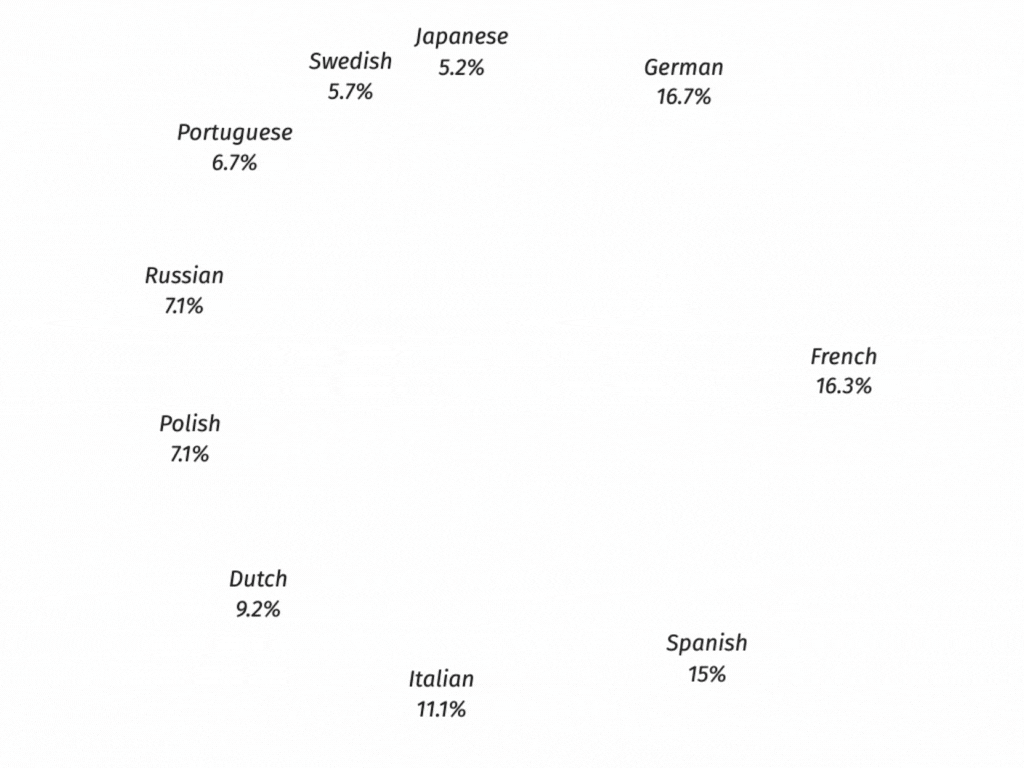
Are you looking to venture beyond your native market? Then you need localization. And to effectively navigate the global marketplace, understanding the most popular languages for localization is essential.
Determined to provide you with valuable insights into the most sought-after languages for localization, we gathered the following data from our extensive client base. We’ve identified the top ten languages that businesses using POEditor prioritize when expanding their global reach.
About our data
- Cumulative data spanning the entirety of available records.
- The data is sourced from clients who have utilized both human translation services and automated translation solutions.
- Translations primarily originated from English but encompass various other languages as well.
- Languages exhibiting regional distinctions are evaluated independently.

1. German
German, spoken by over 130 million people worldwide, ranks as the most sought-after language for localization. Its widespread usage in Europe, particularly in Germany, Austria, and Switzerland, makes it an attractive target for businesses aiming to tap into this valuable market. Germany is a powerhouse in industries such as automotive, engineering, and finance, making localization into German a priority for businesses seeking to tap into this thriving market.
2. French
French, with over 250 million speakers globally, holds the second position in the localization landscape. As the language of diplomacy, culture, and international relations, it holds significant importance in the localization sphere. Businesses looking to expand into regions with a strong Francophone presence prioritize French localization to resonate with the diverse communities in these areas.
3. Spanish
Spanish, spoken across continents by over 500 million native speakers, is a language that connects diverse communities in Europe, Latin America, and beyond. Companies aiming for a global footprint find Spanish localization essential for reaching audiences in Spain, Latin American countries, and the United States.
4. Italian
Italian, spoken by over 60 million people worldwide, is also one of the most popular languages for localization. Italy, known for its rich cultural heritage and contributions to art and fashion, attracts businesses seeking a foothold in this dynamic market. Italian localization is crucial for companies aiming to engage with Italian consumers who appreciate content tailored to their language and cultural nuances.
5. Dutch
The Netherlands boasts a robust economy and a tech-savvy population, making Dutch localization an integral part of expansion strategies. Furthermore, Dutch is spoken by over 28 million people. Companies recognize the importance of addressing the Dutch-speaking audience to establish a meaningful presence in this thriving market.
6. Polish
Poland has emerged as a key player in the European Union, with a growing economy and a tech-driven workforce. With over 40 million speakers, Polish is a language used in Poland and parts of Eastern Europe, making it a strategic option for businesses expanding into these markets. Localization into Polish is on the rise as businesses recognize the potential of engaging with Polish consumers.
Improve your localization process
Discover an easy to use and affordable localization app.7. Russian
Russian is the most spoken native language in Europe, boasting over 250 million native speakers. Russia’s vast market and diverse consumer base make Russian localization a strategic move for companies eyeing opportunities in this expansive country. Addressing the linguistic and cultural preferences of Russian consumers enhances a brand’s ability to connect with this unique market.
8. Portuguese
Portuguese is a global language spoken by over 250 million people worldwide. It ranks ninth among the most spoken languages in the world. As one of the most popular languages for localization, it provides access to diverse markets on more than just one continent. As businesses seek to establish a presence in South America and Europe, Portuguese localization ensures effective communication and resonance with the local audience.
9. Swedish
Sweden’s innovation-driven economy and high English proficiency make Swedish localization essential for businesses looking to tap into the Nordic region. Addressing the Swedish market (and its over 10 million speakers) reflects an understanding of local preferences and increases the chances of success in this tech-savvy nation.
10. Japanese
Japan, a global technology and innovation hub, presents immense opportunities for businesses. Japanese is spoken by over 125 million people and has also made it on our list of the hardest languages to translate and localize. But don’t let that scare you, as it’s also one of the most popular languages for localization. Localizing your content into Japanese is a strategic move to cater to the unique linguistic and cultural nuances of this market, fostering better engagement with Japanese consumers.
What do the statistics say?
According to W3Techs stats, English is the predominant language on the Internet, utilized by 52.6% of websites. Following closely are Spanish (5.4%), German (4.7%), Russian (4.6%), French (4.3%), Japanese (4.2%), and Portuguese (3%), ranking as the subsequent most commonly used languages online.
These findings regarding the prevalence of languages on the Internet strongly align with the localization trends observed in POEditor’s data. The correlation between the global usage of languages on the Internet and the prioritized languages for localization underscores the importance of catering content to the linguistic preferences of diverse online audiences.
Based on findings from Translated’s Research Center, broadening the translation of your website to encompass content tailored for the United States, China, Japan, and Germany is expected to open up access to around 50% of the global sales potential.
The data underscores the idea that effective website localization involves tailoring content to languages that are not only widely spoken but also strategically chosen based on economic and consumer considerations in specific regions.
Continue reading:
Does speaker base size influence a language’s popularity for localization?
The size of the speaker base plays a pivotal role in determining the suitability of a language for localization. A larger speaker base often indicates a broader and potentially more diverse audience, making the localization efforts more impactful and relevant.
However, our data suggests that this may not always be the case. Other factors, such as market demand, cultural relevance, and industry-specific considerations, could override the sheer number of speakers in influencing the decision to localize into a particular language.
This highlights the importance of a nuanced approach to language localization, taking into account a variety of factors for a more accurate and strategic decision-making process.
How to choose your localization languages
While the POEditor data offers a foundation for understanding the most popular languages for localization, a tailored approach is essential. Here are essential considerations to guide you in selecting the most relevant languages for localization:
- Identify the demographics and preferences of your target audience.
- Evaluate the market potential in different regions. Analyze economic factors, industry trends, and consumer behavior to identify regions where localization can yield the highest impact.
- Assess the languages in which your competitors are investing. Analyzing the localization strategies of industry peers can provide insights into market demands and help you make informed decisions.
- Consider the nature of your product or service. Certain offerings may have a more significant impact in specific regions, making it essential to prioritize languages that align with the product’s appeal.
- If your business has plans for global expansion, select languages that align with your expansion roadmap. Prioritize languages that open doors to new markets and facilitate seamless integration into diverse cultural landscapes.
- Gather insights from customer feedback and inquiries. Customer input can highlight languages that are in demand or areas where localization could enhance user experience.
- Consider the technological landscape of target regions. Some languages may be more relevant in tech-driven markets, aligning with innovation trends and facilitating smoother adoption of your product or service.
By conducting a thorough analysis of target audiences, markets, and business goals, you can make informed decisions that go beyond general trends, ensuring a more strategic and effective language localization strategy.
Localize languages with POEditor
POEditor is a translation management system that simplifies the process of localizing your products and services into multiple languages, whether they’re popular and high-resource languages, or low-resource languages. With POEditor, you can manage your translation projects, collaborate with translators, and track the progress of your localization efforts all from a single, centralized platform.
Register an account, create a project, define your project scope, and start localizing. Import your source content into POEditor and send translation requests to your team of translators or freelancers. Or you can choose from our other translation options.
Our tool that can help businesses of all sizes localize their products and services into multiple languages. With our user-friendly interface, advanced features, and competitive pricing, we can localize your languages efficiently, accurately, and cost-effectively.